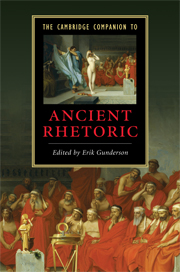Book contents
- Frontmatter
- Introduction
- Part 1 An archaeology of rhetoric
- Part II The field of language
- Part III The practice of rhetoric
- 8 Types of oratory
- 9 Rhetoric of the Athenian citizen
- 10 Rhetoric and the Roman Republic
- 11 Staging rhetoric in Athens
- 12 The drama of rhetoric at Rome
- 13 Rhetoric and the Second Sophistic
- Part IV Epilogoues
- Appendix 1: Rhetorical terms
- Appendix 2: Authors and prominent individuals
- References
- Index of passages
- Index of subjects
- Series list
12 - The drama of rhetoric at Rome
from Part III - The practice of rhetoric
Published online by Cambridge University Press: 28 January 2010
- Frontmatter
- Introduction
- Part 1 An archaeology of rhetoric
- Part II The field of language
- Part III The practice of rhetoric
- 8 Types of oratory
- 9 Rhetoric of the Athenian citizen
- 10 Rhetoric and the Roman Republic
- 11 Staging rhetoric in Athens
- 12 The drama of rhetoric at Rome
- 13 Rhetoric and the Second Sophistic
- Part IV Epilogoues
- Appendix 1: Rhetorical terms
- Appendix 2: Authors and prominent individuals
- References
- Index of passages
- Index of subjects
- Series list
Summary
Drama is generally taken as a representative art: it is not life, but it represents life. It is the art of actors pretending to be something that they are not. Rhetoric is generally taken as the art of using words to persuade and manipulate, irrespective of the truth, essence, and sincerity; it is the art of pretense and the constructed truth. In Rome, in particular, it is primarily the art of lawyers who represent and advocate for their clients, speaking for them, even acting out emotions that their clients are presumed to feel. It is an accident of language that both the actor and the lawyer are called actores (after all, herdsmen, bailiffs, and artillery men are also actores): the term refers to the one who performs the material task (as opposed to, say, a producer). But the accident underscores similarities: the performances of actores as representatives of others (characters or clients) are artistic, manipulative, insincere. They are the ones who hide behind the mask, manipulate the mask, make you see what you do not see.
But orators also represent themselves, their auctoritas (personal authority and influence) and their character. The courtroom is the stage where they assume the persona of the uir bonus (the good or manly man). One version of the uir bonus was the sincere speaker, the man of no artifice. But how do you act like uir bonus? Cato the Censor, a man who inveighed against Greek rhetoric and influence and had the orators tossed out of Rome, reduced rhetoric to a simple formula: tene rem, uerba sequentur! (“Stick to the truth; the words will follow.”) But Cato himself studied rhetoric and had his sons learn Greek.
- Type
- Chapter
- Information
- The Cambridge Companion to Ancient Rhetoric , pp. 212 - 227Publisher: Cambridge University PressPrint publication year: 2009
- 15
- Cited by

